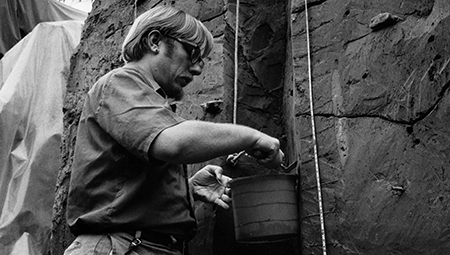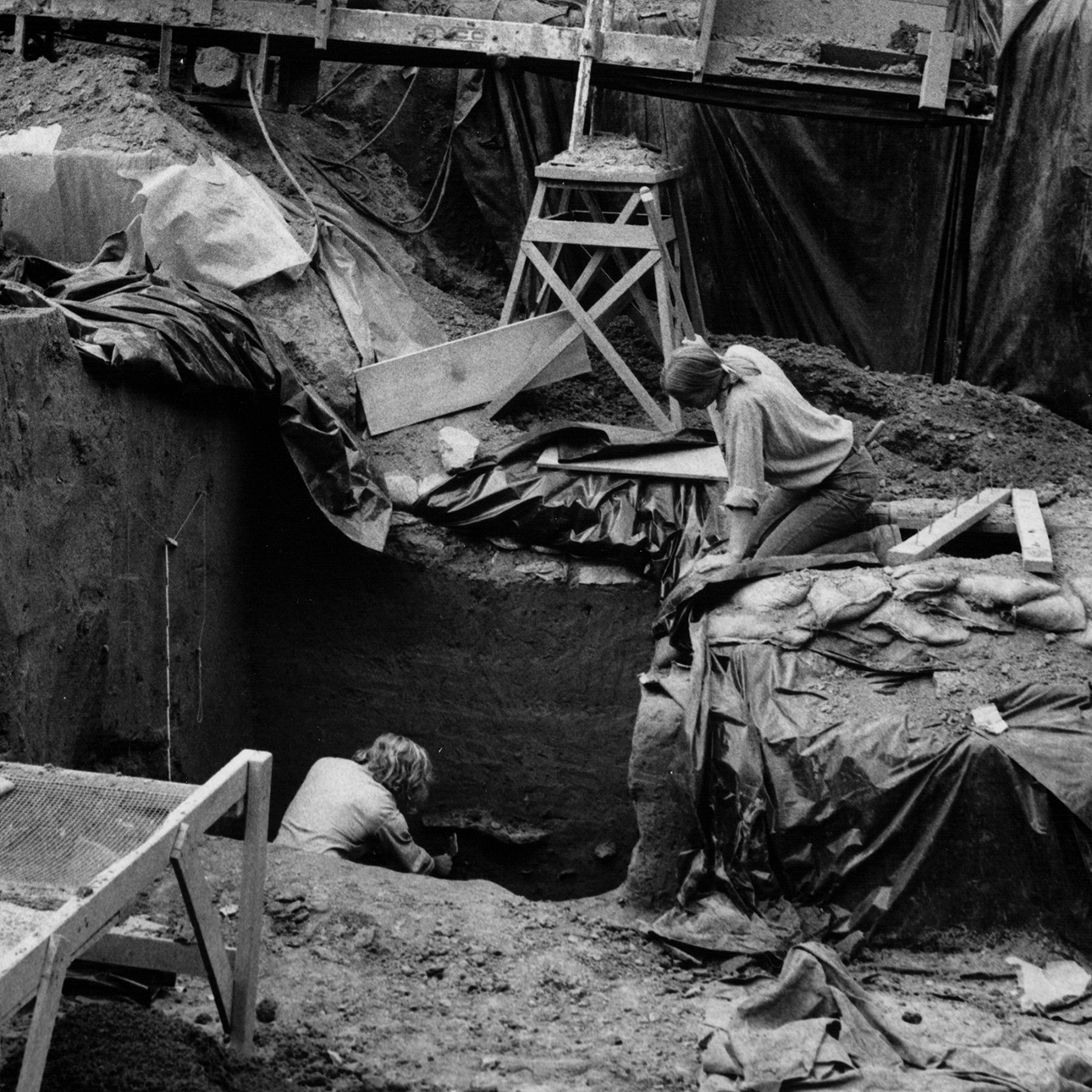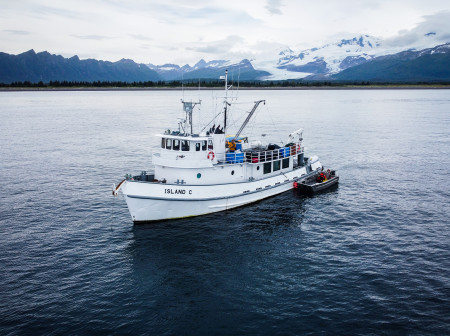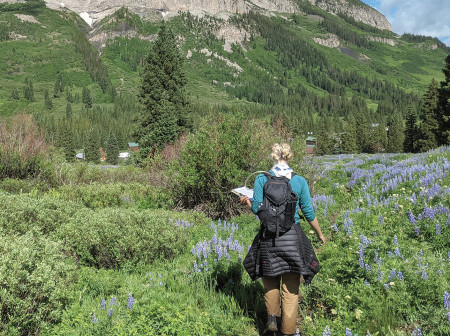In the late 1960s southern Illinois farmers reported finding arrowheads and bits of pottery — signs of an ancient civilization — when they plowed their fields.
Around the late 1960s Ted Koster and his wife, Mary, agreed to let Northwestern anthropologist Stuart Struever ’60 MA conduct an archaeological excavation on their farm. Within the next few years, Northwestern opened an archeological field school along the banks of the Illinois River. For around a decade, dozens of Northwestern students and archaeologists ventured to Kampsville, Ill. — a five-hour drive southwest of Evanston — to conduct excavations at the Koster site, uncovering thousands of artifacts, including bones, remnants of prehistoric houses and other items.
 Struever’s dig led to the discovery of 25 distinct “horizons” — layers of artifacts from specific cultural time periods — dating back to the Archaic Period (8000 B.C. to 600 B.C.). The Koster site, which at one time drew more than 10,000 visitors annually, was added to the National Register of Historic Places in June 1972. Struever founded the Center for American Archeology in Kampsville.
Struever’s dig led to the discovery of 25 distinct “horizons” — layers of artifacts from specific cultural time periods — dating back to the Archaic Period (8000 B.C. to 600 B.C.). The Koster site, which at one time drew more than 10,000 visitors annually, was added to the National Register of Historic Places in June 1972. Struever founded the Center for American Archeology in Kampsville.
“Struever was a really good salesman,” recalls Jim Carper ’79, who took the professor’s introductory anthropology class his first year at Northwestern. “He painted this image of the summer program — going to the Koster dig and uncovering all these artifacts and exploring past civilizations. He spun a pretty good tale about being an archaeologist and why it was important to do the science. It sounded like a lot of fun.”
Carper says he was surprised by the rustic living conditions. “Kampsville was a little town of about 400 people on the Illinois River in farm country. It had a bank and a bar and not much else.
“We would get up in the morning, eat breakfast and get on a school bus. We had to cross the Illinois River on a ferry, so that was always exciting, maneuvering the school bus onto the ferry.
“I was there in the summer of 1977, and by that time the site was a big open pit. We descended two stairways down to the bottom. And once there, it was all divided into grids, 3 feet by 3 feet. The assignment was to excavate an inch at a time. It was kind of painstaking.”
In the evenings, after dinner, professors from Northwestern and guests from the Museum of Science and Industry and other institutions would offer lectures at the Center for American Archeology.
“I learned a little bit of geology, biology, ecology and human behavior,” explains Carper, who now lives in Glencoe, Ill. “I liked the perspective that all these different scientists came together and explained what had happened there. I found that very interesting.”
 Around the same time, Donald Albertson ’73, ’79 MA and his colleagues discovered human remains at the nearby Helton Mounds. Field school students at that site, under the direction of former Northwestern professor Jane Buikstra, excavated skeletons as well as pottery and stone tools.
Around the same time, Donald Albertson ’73, ’79 MA and his colleagues discovered human remains at the nearby Helton Mounds. Field school students at that site, under the direction of former Northwestern professor Jane Buikstra, excavated skeletons as well as pottery and stone tools.
Albertson worked in the Helton Mounds osteology lab, where he meticulously labeled and preserved skeletal remains. The following year, Buikstra hired Albertson as her lab supervisor.
When federal funding for the excavation and preservation projects dried up, “I got out of archaeology,” says Albertson. But the work at Koster and Helton “was a huge turning point in my life, even though I didn't realize it at the time. Being part of the program gave me a lot of flexibility and knowledge that I wouldn't have gotten otherwise and allowed me to adapt to whatever circumstances people threw at me.”




Reader Responses
I was there in the late '70s when I was in junior high school, and I remember staying in rustic bunkhouses with the mattresses on the floor and eating Tombstone pizza and playing pinball at the bar in the evening. Being a kid in the 70s rocked. :) I seriously thought of majoring in anthropology or archeology as a result of the experiences I had working at the dig sites.
—Mary Werner Madisonville, Ky.
I was there as a middle school student for archaeology camp in the summer of '77, and it was a blast. We learned how to flintknap and hunt for chert in the river.
—Ian Harr Huntley, Ill.
I did the Roycemore archaeology summer school — classes and then the dig — and went to Kampsville in 1980, just after eighth grade. It was one of the formative experiences of my life. We learned so much about early American life, from flint knapping to hunting, and we learned so much about the theory and practice of real archaeology. And we saw a tornado from about 2 miles away!
As an undergrad at NU ('88), I took the Intro to Archaeology class taught by Stuart Struever too — and on the last day of class, before the final, a lot of the grad students came up to the lectern to tell us, basically, "don't go into the field; you'll never have a secure job, and you'll be chasing road crews and bulldozers for sites that have already been destroyed."
Ouch!
—Abra Quinn '90, San Leandro, Calif., via Northwestern Magazine
I was there. Our fourth-grade teacher, Mrs. Sachs, put together a group of students from the gifted program at Anne Sullivan School to attend a summer program at the Koster Site. I attended lectures, made spearheads out of flint, worked on a portion of the site alongside archeologists. It taught me so much and taught me about patience! Wonderful experience.
—Cheryl Golemo '95 MA, Arlington Heights, Ill., via LinkedIn
Well before I was an undergrad, my older brother and I did a week of archeology camp at Koster and Kampsville, through a Northwestern summer program. It was supervised by a couple of middle school teachers (and Northwestern affiliates) my mom had once taught alongside. Good experience. I learned something about archeology, got to know kids from other parts of Illinois, and, memorably, had some kid's chewing tobacco spit whip right at my face when he dumped his cup over the side of the pickup truck bed that was taking us to the dig site. (Adults thought it was fine to put a bunch of kids in the bed of a pickup truck for a ride to an archeology site in the late 1970s!)
—Steve Plank '90, Silver Spring, Md., via Northwestern Magazine
I worked the Koster site one summer back in the late '70s; what a great experience. In addition to the dig, we had an opportunity to learn ceramics and work flint. Awesome program!
—Brian Braun Illinois, via LinkedIn
I went to Kampsville with Hannah Struever, daughter of Stuart, as a kid. It was so cool to see an archeology dig in real life — and right in central Illinois!
—Suzi Katlin Illinois, via LinkedIn
No one has commented on this page yet.
Submit a Response